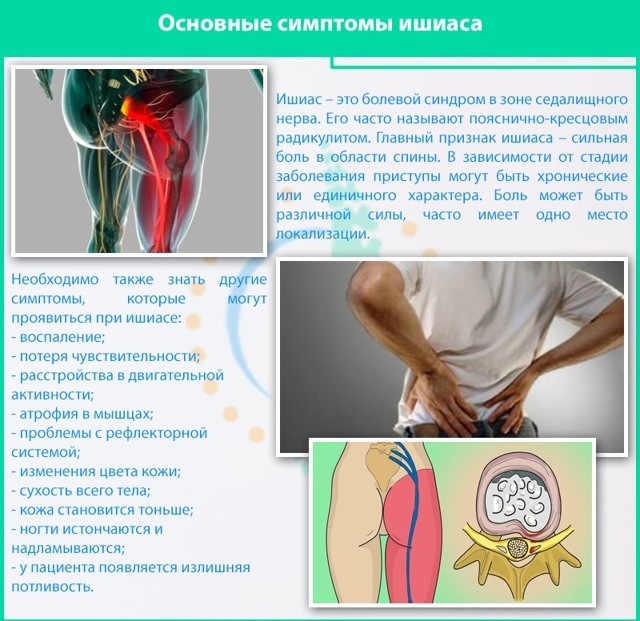Content
- Normal liver sizes in children and adults
- Causes of hepatomegaly of the liver
- Inflammatory diseases
- Infiltrative processes
- Fibrous liver changes
- Stagnant processes in the liver
- Focal liver damage
- Mixed liver damage
- Types and forms of pathology
- Unexpressed
- Moderate
- Expressed
- Symptoms of moderate hepatomegaly, where it hurts
- Diagnosis of moderate hepatomegaly
- Laboratory research
- Instrumental research
- Echoes and ultrasound signs of pathology
- Treatment of moderate hepatomegaly
- Medicines
- Nutrition and diet
- Consequences of hepatomegaly and prognosis
- Answers to frequently asked questions
- Is hepatomegaly treated with folk remedies?
- Do they take into the army with an enlarged liver?
- What can be the reasons for an enlarged liver in a child?
- Is it possible to play sports with an enlarged liver?
- Is hepatomegaly and hepatosis the same thing?
- How long do they live with hepatomegaly?
- Video about hepatomegaly
Hepatomegaly is a disease characterized by an increase in the size of the liver. Pathology has numerous causes of development and can occur in both pronounced and moderate forms.
Normal liver sizes in children and adults
There are norms for the size of the liver in an adult and a child. This indicator is determined by tapping and depends on the height of the person. With an average height, the dimensions of the organ are 9 × 8 × 7 cm.
If a person's height is above average, the size of the liver can increase within 1 cm. With a short stature, the standard indicators are reduced by 1 cm. You can also determine the size of the organ using ultrasound. In this case, parts of the lobes of the organ.
Standard indicators:
- right lobe - 12.5 cm;
- left lobe - 7 cm;
- transverse size - from 20 to 22 cm.
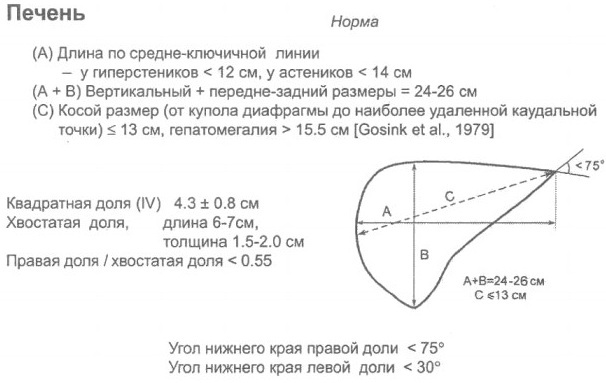
| Child's age | Left lobe | Right lobe |
| Newborn | 3-3.5 cm | 5.7-6.1 cm |
| Children from 1 year old | 3.3-4 cm | 6 cm |
| Teenagers from 15 years old | 5 cm (+1.5 mm) | 10 cm |
| From 18 years old | 5 cm (+1.5 mm) | 12 cm |
Causes of hepatomegaly of the liver
There are many different reasons for the enlargement of the liver. The most common organic causes of the development of pathology.
Inflammatory diseases
All inflammatory diseases are divided into 3 main types or types of etiology - toxic, infectious and autoimmune.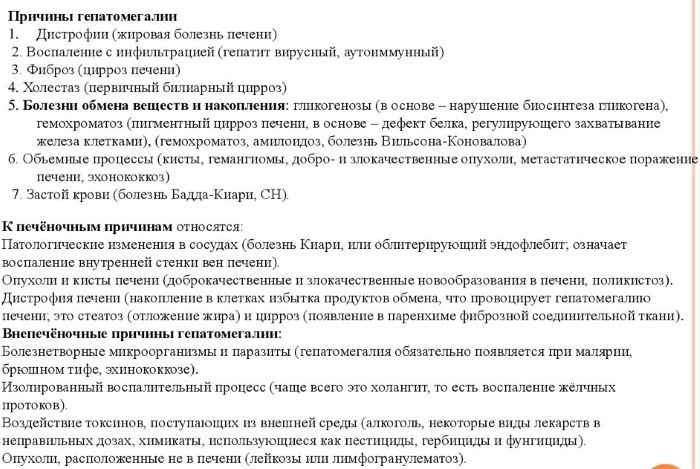
Classification (description):
- Infectious processes. An increase in baking occurs against the background of viral and bacterial damage to the organ. Such violations include various forms of hepatitis, herpes infection, tuberculosis, septic lesions, typhus, syphilis, protozoan parasitic infestations, malaria, giardiasis.
- The toxic nature of the origin. Inflammatory diseases occur against the background of organ intoxication caused by alcohol, chemicals or medications.
- Autoimmune form. As a result of autoimmune disorders, the body's own body begins to produce protective cells that attack the liver. Most often, pathology occurs as a result of such autoimmune processes as sclerosing cholangitis (primary form), biliary cirrhosis or hepatitis (an autoimmune type of disease).
Against the background of inflammatory processes, a pathological enlargement of the liver occurs. Moreover, the severity of the disease depends on the factors that provoked its development.
Infiltrative processes
Moderate hepatomegaly of the liver is a disease that can also be a sign of the development of infiltrative processes. Infiltration occurs as a result of the accumulation of various harmful substances in the cells of the organ - cholesterol, fats, copper, iron.
Reasons for development:
- Impaired metabolism (genetic predisposition).
- Improper nutrition. Insufficient protein intake, as well as excessive intake of fats and carbohydrates, leads to the development of the disease.
- Endocrine Disorders. Liver size can increase due to diabetes mellitus or hyperthyroidism.
- Various blood diseases.
- Malfunctions in the gastrointestinal tract, including ulcerative lesions and the presence of neoplasms (including malignant forms).
- Connective tissue diseases.
Also, a violation can develop during surgical interventions, burn conditions, injuries.
Fibrous liver changes
Fibrous tissue is formed as a result of chronic inflammatory processes occurring in the liver. In this case, healthy tissue is replaced by connective tissue, which leads to the occurrence of fibrosis. When the condition worsens, cirrhosis of the liver can develop.
Stagnant processes in the liver
Pathological changes in the liver often occur against the background of a violation of the venous outflow or outflow of bile. The most common causes are heart failure, cholangitis, myocarditis, and blockage of the bile ducts.
Focal liver damage
These violations are manifested in the development of pathological changes in certain parts of the organ.
Focal lesions leading to an enlarged liver:
- Neoplasms (tumors). These processes include primary tumors, as well as metastases that radiate to the liver.
- Cystic formations.
- Abscess. Pathology is a small area in which pus accumulates.
Against the background of these processes, the size of the liver can increase significantly.
Mixed liver damage
The liver can also enlarge as a result of several diseases at once. The risk group includes elderly people who have several pathologies at the same time, including a reduced functioning of the immune system. With the mixed type, the prognosis is less favorable, the disease itself is more pronounced and requires more time for treatment.
Types and forms of pathology
Moderate hepatomegaly of the liver is a pathology that is divided into several forms. There are 3 main types of disorders, each of which is characterized by its own symptoms, severity of pathology and severity.
Unexpressed
With this type of pathology, there are no symptoms, however, the size of the liver increases by 1-2 cm. It is possible to identify violations only with the help of ultrasound.
Moderate
With this type of violation, there is a slight increase in the size of the organ. At the same time, symptoms may be absent or have an unexpressed form.
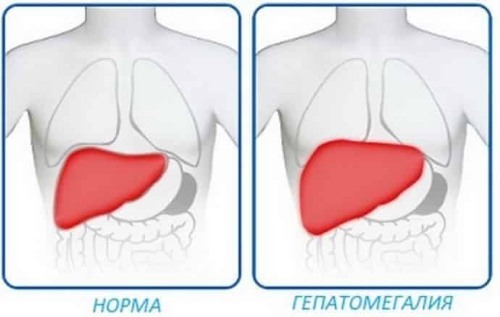
Most often, the disease occurs against the background of improper diet or alcohol abuse.
Expressed
This type of disease is characterized by a significant increase in the liver and a pronounced clinical picture. In this case, the disease progresses rapidly and can fill the entire peritoneal area.
The most common causes are cancer processes.
Symptoms of moderate hepatomegaly, where it hurts
At the initial stages of the development of the disease, any symptoms may be absent. As the disease progresses, the symptoms become more pronounced.
Symptoms:
- a feeling of heaviness in the area of the right hypochondrium;
- flatulence, bloating;
- sore on the skin, accompanied by itching;
- soreness in the right sides (while the attacks of pain can intensify when pressed);
- yellowing of the skin;
- discomfort and other discomfort in the right side;
- stool disorders;
- heartburn;
- bad breath.
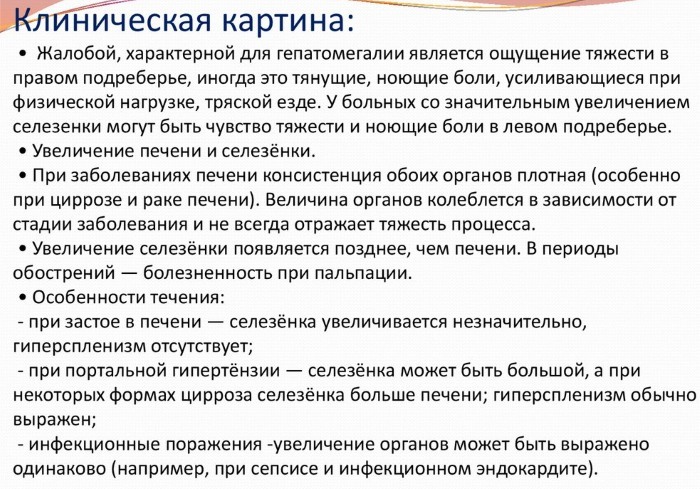
General health also worsens. Weakness and malaise occurs.
Diagnosis of moderate hepatomegaly
If a pathology is suspected, in addition to visual examination and organ tapping, additional research methods are prescribed.
Laboratory research
Laboratory studies help determine the presence of inflammatory processes, as well as establish the cause of the development of the disorder.
Survey methods:
- general examination of blood, urine and feces;
- blood chemistry;
- liver function tests;
- immunogram;
- fibromax;
- blood clotting assessment (coagulogram);
- if necessary - research for oncology (tumor markers).
After decrypting the data received, the specialist prescribes treatment or sends it for additional research.
Instrumental research
Instrumental diagnostics is carried out as part of complex measures that help to establish the cause and area of liver damage.
Research types:
- Ultrasound of the abdominal organs;
- X-ray examination;
- MRI;
- puncture biopsy (collection of biological material);
- radiological examination of the organ (scintigraphy).
Only after all the studies have been carried out, a diagnosis is made and a treatment regimen is developed.
Echoes and ultrasound signs of pathology
In case of unexpressed symptoms of the disease, an ultrasound examination is prescribed, which will assess the severity of the disorder. Diagnostics helps to determine the structure of the liver, as well as its size. With an increased volume of an organ, a specialist examines its structure. As a rule, it becomes darker and denser.
Changes are also seen in the area of the hepatic parenchyma. Its areas become limited and smaller in area. Diagnostics allows you to identify additional signs in the form of metastases, abscesses or neoplasms. However, in most cases, with a moderate form of pathology, these symptoms are absent.
Treatment of moderate hepatomegaly
Hepatomegaly of the liver, proceeding in a moderate form, requires an integrated therapeutic approach and includes taking medications and adhering to dietary rules.
In addition to the general scheme or depending on the cause of the pathology, it is necessary adhere to a healthy lifestyle - adherence to regimens, sleep, exercise, refusal bad habits.
In more complex cases, surgery or chemotherapy (if cancer is detected) may be necessary.
Medicines
First of all, drugs are prescribed, which are selected based on the reason that provoked the development of the disease.
Preparations:
-
Hepatoprotective agents. Representatives: Geptral, Ursofalk, Carsil. These drugs have antioxidant, neuroprotective, choleretic and antitoxic effects. They are used for cirrhosis, cholestasis, hepatitis, fatty degeneration of the liver, toxic lesions, as well as in the presence of stones in the gallbladder. Some of the funds can be used in the recovery period after suffering liver diseases.
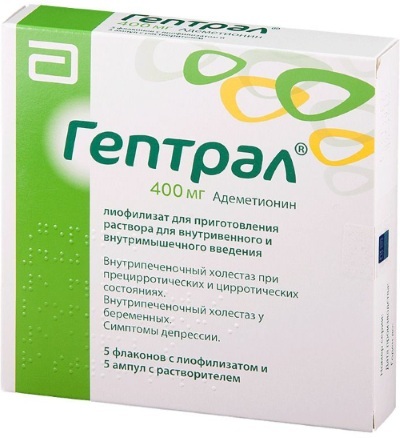
Heptral tablets - Phospholipids. List: Phosphogliv, Essentiale Forte, Rezalut Pro. Medicines are prescribed to restore the structure and functions of the liver, normalize lipid and protein metabolism. They are used for chronic hepatitis, cirrhosis, toxic damage (including taking medications), as well as during the rehabilitation period.
- Hypolydemic drugs. In most cases, statins are used to help lower blood cholesterol levels.
- Antiviral agents. Representatives: Ribavirin, Acyclovir, Cycloferon. They are prescribed for liver damage caused by viral infections. Effective against hepatitis B and C.
- Immunomodulators. List of funds: Imudon, Imunofan, Polyoxidonium. Indications: viral forms of hepatitis, infectious and viral liver damage, rehabilitation, cancerous tumors.
- Enterosorbents. Preparations: Dufolac, Enterosgel, Lactofiltrum. These drugs help eliminate toxins caused by bacteria, viruses, ethanol. Purpose: viral or toxic hepatitis, cirrhosis, toxic liver damage, encephalopathy.
In some cases, or after therapy, various vitamin complexes may be prescribed in addition.
Nutrition and diet
With an increased size of the organ, it is required to follow some nutritional rules, and you should also adhere to the dietary table No. 5 according to Pevzner.
Nutrition principles:
- You should adhere to fractional nutrition - meals are taken every 3-4 hours in small portions (6 times a day).

- It is necessary to limit salt intake - no more than 10 g per day.
- Food should be warm, not cold or hot.
- Dishes must be baked, boiled, stewed or steamed.
- All food is recommended to be taken in the form of gruel.
- Compliance with calorie intake - no more than 2000.
- Reduce the amount of protein (90 g), fat (90 g) and carbohydrates (400 g) consumed.
It is also necessary to observe the drinking regime and drink at least 2 liters of liquid per day.
Consequences of hepatomegaly and prognosis
In the absence of timely treatment, the disease can worsen and lead to health and life-threatening consequences.
Possible complications:
- Ascites is an abnormal accumulation of fluid in the peritoneum.
- Varicose veins in the digestive tract.
- Liver failure is a dysfunction of an organ.
- Hepatic encephalopathy is a neuropsychiatric disorder accompanied by inadequate cell production.
- Fibrosis formation. Pathology is the replacement of healthy liver tissue with connective tissue. In this case, various scars are formed on the organ.
- Carcinoma is the occurrence of a malignant neoplasm (primary form).
In the moderate form, the prognosis for full recovery is favorable. In the presence of oncological processes, the chances of clinical recovery are significantly reduced. The prognosis is unfavorable.
Answers to frequently asked questions
Moderate hepatomegaly of the liver is a disorder that requires careful and effective treatment.
With the development of the disease, many patients have various questions, the answers to which allow better understand the principles of treatment and help to get rid of it faster and prevent recurrence occurrence.
Is hepatomegaly treated with folk remedies?
Traditional methods of treatment can be used, but only as an additional treatment. You should consult with your doctor in advance about this, since some of the herbs may have contraindications for admission.
The following remedies can be used for treatment:
- milk thistle;

- peppermint;
- sandy immortelle;
- pharmaceutical camomile;
- dandelion medicinal.
You can familiarize yourself with the methods of using plants by studying the instructions for preparing the infusion and decoctions.
Do they take into the army with an enlarged liver?
The conscription of men liable for military service with hepatomegaly depends on many concomitant factors - the presence of additional health problems, the general condition of the conscript, as well as the reasons that caused disease.
To confirm the diagnosis, the conscript must provide a document (extract from the medical history).
After that, a special commission is assembled, which must conduct an examination and, if necessary, appoint additional diagnostic methods. When confirming the diagnosis, the commission determines whether the conscript is fit, if there, then in which troops.
To determine the suitability of a conscript, the position "Schedule of diseases" ("Regulation on medical and military expertise") is used. At the same time, an act is drawn up, where data and a category are entered, on the basis of which a decision is made.
It should be borne in mind that refusal to undergo additional studies is calculated as a deviation from military service.
What can be the reasons for an enlarged liver in a child?
There may be several such reasons.
In newborns, the disease can occur against the background of the following disorders:
- infectious liver damage;
- cholestatic diseases;
- disorders of metabolic (metabolic) processes;
- the presence of neoplasms;
- liver intoxication, including those caused by medications.
Also, in children, pathology can develop as a result of trauma, hereditary predisposition, endocrine disorders, autoimmune disorders, congenital anomalies.
Is it possible to play sports with an enlarged liver?
Moderate hepatomegaly of the liver is a disease that requires an integrated approach to treatment. Physical activity and sports are often prescribed as additional therapeutic measures, since it helps to get rid of extra pounds, strengthen muscles, and increase the work of the immune system.
However, before starting classes, you should consult a doctor, especially for patients with diseases of the cardiovascular system. A specialist will individually select the required set of exercises.
Is hepatomegaly and hepatosis the same thing?
These diseases are completely different, since hepatosis is a separate disease, while how hepatomegaly can be just a sign indicating other internal diseases organs.
Hepatosis is a collective name for various liver lesions in which there is a failure in the metabolism of hepatocytes. This, ultimately, leads to the oppression of the functions of the organ. In this case, one of the symptoms of hepatosis may be an increased size of the liver.
How long do they live with hepatomegaly?
The patient's life expectancy depends on several factors - the severity of the pathology, the reasons that provoked the disease, the effectiveness and initiation of therapy.
In inflammatory diseases, a person's life span can exceed 10 years. In the case of infiltrative processes, the survival rate is about 90% within 5 years after diagnosis. With fibrous growths, life expectancy ranges from 4 to 20 years, depending on the stage and severity of the pathology.
For congestion, the 10-year duration after diagnosis is about 55%. At the initial stages of focal lesions, clinical cure occurs in 90%. With the development of complications and liver failure, the chances are significantly reduced and range from six months to 1.5 years.
With mixed diseases, the patient's life expectancy depends on concomitant factors. The prognosis is unfavorable.
At the first signs of moderate hepatomegaly, you should consult a doctor to avoid complications. Timely therapy and adherence to all the recommendations of a specialist allow you to achieve complete clinical recovery and completely restore the liver.
Video about hepatomegaly
What is hepatomegaly:


